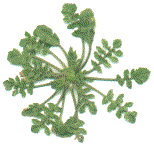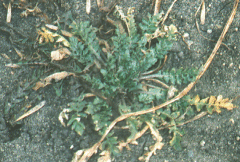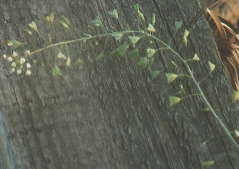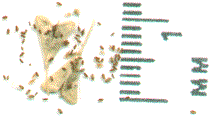|
|
 |
 This hardy annual, (which often grows as a winter annual), is of European origin but is now naturalized around the world except in tropical climates.
This hardy annual, (which often grows as a winter annual), is of European origin but is now naturalized around the world except in tropical climates.
Shepherd's purse does its best in sunny, moist to dry, rich, disturbed soil, but it will also grow in partly shaded, extremely poor soils. One of the reasons for this is that the plant has sticky seeds, to which tiny insects get stuck, providing the seedling with extra food. I generally find this plant growing in sunny gardens and flowerbeds. I also often see it in lawns, along the edges of sidewalks and paths, and sometimes growing through sidewalk cracks. |

Shepherd's purse has a slender, flexible, slightly hairy, white taproot, from which arises a basal rosette quite similar to that of a dandelion (Taraxacum officinale). The rosette generally grows to be 4" to 8" in diameter. The basal leaves are stalked, and the first leaves are usually rounded, while the later leaves are usually deeply toothed but may be rather variable. Smaller, slightly toothed, alternate leaves clasp the flowerstalk, which generally reaches 6" to 18" in height. The white flowers appear in clusters at the top of the stalk. The flowers are only about 2 mm across. Like all Brassicaceae flowers, they have 4 petals which form a cross and 6 stamens. The flowers are self fertilizing. As the first flowers are maturing, the stalk continues to grow and produce new flowers. |

Shepherd's purse can be found in flower from early spring through early winter. Each flower develops into a heart-shaped, two-celled seedpod, about 5 mm long, containing a number of tiny seeds. When the pod dries, it splits in half, releasing the mature seeds. People have been eating this plant for thousands of years and it is presently cultivated in a number of eastern countries. Shepherd's purse is one of the earliest wild greens in the spring. In the early spring, before the flowerstalks appear, the leaves are good in salads or cooked as greens. When the plant flowers, the larger basal leaves tend to die off, leaving only the smaller leaves clasping the stem. They're still edible, but they get tougher, develop more flavor, and become labor-intensive to collect. When harvesting the plant, you may notice a distinctive, and not quite pleasant odor. Don't worry, it doesn't taste like that. So far my favorite way to cook the greens is to put them in a loosely covered dish with a little water, some mushrooms, and a sprig or two of thyme, microwave it on high for 4 minutes, and serve with butter. They are also very good to mix with other greens. The young roots are also edible, but I either haven't developed a taste for them yet or haven't stumbled upon the proper method of preparation. I have read that the seedpods can be used for a peppery seasoning, but the ones I've tried have had little flavor. The seeds themselves can be ground into meal or used as is. The leaves are very high in thiamin (B1), choline, inositol, and fumaric acid. They are a good source of ascorbic acid (C), riboflavin (B2), calcium, potassium, and phosphorus. They also provide beta carotene (A), vitamin K, niacin, iron, and rutin. For medicinal use, the whole plant in flower is used (except the roots) usually in the form of a tea or infusion. Either fresh or dried material may be used, but fresh is preferred as the dry material soon loses its medicinal properties. Shepherd's purse is astringent, anti-inflammatory, hemostatic, and diuretic. It constricts the blood vessels (usually), lowers blood pressure (usually), and contracts the uterus. It is used during or after childbirth and to ease difficult menstruation. This plant should not be used by pregnant people. It also contains compounds (such as fumaric acid), which are known to have anti-cancer effects. The tea is sometimes recommended as a general tonic. Externally, shepherd's purse has historically been used as an astringent and styptic to treat wounds. Caution is advised as human skin may blister from contact with the seeds. A variety of birds, including grouse and goldfinches, eat the seeds. Chickens will apparently eat the whole plant, possibly affecting the color and taste of the eggs. Dairy cattle will also eat it, and this may affect the flavor of the milk. The seeds, aside from sticking to insects, are also reported to be toxic to mosquito larvae, and, when put in the water, may possibly help control mosquitos. Shepherd's purse will also absorb excessive salts from the soil, and may be planted for that purpose. A single plant may produce a couple thousand seeds, and the seeds may remain viable for many years. So, to control this plant, pull it up before it goes to seed, and use mulch where possible, as the seeds remain dormant in the dark.
Selected References
|
|
| Home | About this site | Asides/Glossary | Store |
| Taxonomy Tree | Species list | Article list | |
|
Featured sponsors:
|
Mountain Rose Herbs Bulk herbs, teas, oils, & much more! |
Richter's Herbs Seeds & plants |
|
|
© 1999-2015 by Deb Schwartz. All rights reserved. Please send feedback to: deb@kingdomplantae.net Website by ki-yi.com
|
|||